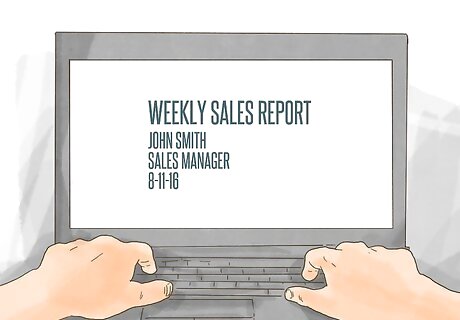
views
Organizing Your Information

Identify the purpose of your report. While you may be required to submit weekly reports as part of your job duties, keeping your job is not the purpose for the report itself. Determining why your employer wants weekly reports will help you decide exactly what information should go into it, and which items are the most important. Typically your report is supposed to update managers on the status of your projects or assist them in making decisions. For example, if you are a retail store manager, you may be required to submit weekly reports that summarize your sales for the week. Your employer uses this report to evaluate performance, price points, and orders for your store. If you're submitting weekly reports for an internship or research project, the purpose is to show your employer or instructor how much progress you've made and share any major breakthroughs or discoveries.

Determine who will read your report. Identifying your audience is crucial to planning your report. Without knowing who will read your report (and why), you have no way of knowing which information is the most important. Knowing your audience also helps you understand how to write your report and what kind of language to use. For example, you'd write an entirely different report if your audience was a group of five-year-olds than if you were writing it for executives of a major corporation. You also get a better idea of what your audience already knows, and what you need to explain more in-depth or provide additional resources. For example, if you're writing a weekly report on a legal issue that will be read by a group of lawyers, there's no need to provide an in-depth summary of the law. However, such a summary might be required if you were writing about the issue for executives or administrators with no legal training. If your report is required in conjunction with an internship, research project, or other school activity, keep in mind that your audience is not your professor or instructor – even though you may be turning it in to them. To find your audience in this context, focus on the nature of your project and your discipline as a whole.

Prioritize the main points of your report. While you should keep your report as concise as possible, it's still likely that your audience won't be reading the report in its entirety. In recognition of this, you need to put the most important information, or the bottom line, at the beginning of your report. For example, if the purpose of your report is to compare and contrast three different brands of equipment and recommend the one you think would be best for the company to use, your conclusion should go up front. Then you can go on to explain why. Generally, you want the first page of your report to consist of a summary of results, recommendations, or conclusions. Use the rest of the report to dig deeper, and readers will go further if they feel the need or want to expand their understanding of your findings.

Be aware of the typical "fate" of your report. In most cases, weekly reports are required for record-keeping reasons, and they'll be filed accordingly. It isn't common for a weekly report to be read all the way through in most contexts, and you shouldn't expect that it will. However, don't use this as an excuse to fake your way through your report or turn in sloppy work of poor quality. Your report should be a reflection of you and your work ethic. A sloppy report is likely to be noticed, and saying "I knew you weren't actually going to read it" is no excuse for a lackluster work product. While you want the report as a whole to be high quality and well written, focus especially on the portions of the report that your audience is most likely to read. This typically is your executive summary and your conclusions or recommendations. These should be flawless. Keep in mind that your employer isn't failing to read your report because they don't care, or because it's unimportant. People in high-ranking management or executive positions are very busy, and they are adept at gathering the information they need to make a decision efficiently. They won't read the whole report unless they have to – but they'll keep it in case they want to go back and look at it again later.
Formatting Your Report

Ask for samples. Many companies have a standard format for their weekly reports, and the managers or executives may be accustomed to getting their information that way. Using a different format can cause frustration and confusion. This is particularly important with sales reports. Managers become accustomed to glancing at a report and knowing where on the page a particular figure or piece of information will be. If you use a different format, your report will be virtually useless for them because they'll have to actually read through it to find what they need. Speak to administrative assistants and find out if there's a template you can use for formatting, so you don't have to create it from scratch in your word processing application. Many companies have a document template with the correct settings, including margins, tables, paragraph styles, and fonts.

Consider the method of delivery. If you're printing up a paper document, or submitting the document digitally as an attachment, you are going to format your report differently than you would if it is simply to be included in the body of an email. For example, if you're sending your report as an attachment to an email, you should include your executive summary in the body of your email. That way your reader doesn't have to open the attachment to understand the thrust of your report. If you're submitting a paper report, it's more likely that you will need to include a cover letter or title page so that your report can be properly identified and filed. Regardless of how you submit your report, make sure your name is included on all pages, and that all pages are numbered in "X of Y" format. Pages can be easily separated, and people should be able to tell at a glance whether the whole report is there, and who the report came from. You can easily include the required information as a header on each page. For example, your header might read "Sally Sunshine Sales Report, Week 32, Page 3 of 7."

Include an executive summary. The executive summary is a brief summary of the entire report – typically only a paragraph or two, with a couple of sentences for each section of your report. The general idea is that an executive could read this summary and, provided it conformed to their original expectations regarding the issue, they could take action without having to read further. For the executive summary, it's especially important to use clear, concise language that is easy to read. Avoid jargon or terms of art that require any explanation, even if you know your audience is well-versed on those terms. Write the executive summary last, after you've completed all other parts of your report. After all, you can't summarize something that hasn't been written yet. Even if you have a detailed outline from which you plan to write your report, things can change during the writing.

Structure your paragraphs and sections. Once you understand the format in which your report will be presented, draft an outline of the sections of your report that is consistent with the purpose of your report. Check your outline to make sure it flows logically from one section to the next, and make sure it's tailored to the specific audience you've identified for your report. Your report typically will include an executive summary, an introduction, conclusions and recommendations, findings and discussion, and a list of references. You may include appendices of relevant data, as well as a table of contents for longer reports – but weekly reports typically won't be this lengthy. Each section of your report deals with a single topic. Within that section, each paragraph discusses a single idea. For example, if you have a section in your weekly sales report titled "Popular Children's Brands," you may have a separate paragraph for each brand. If you're dividing boy's and girl's clothing, you may have subsections (with appropriate subheadings) for each brand, then one paragraph discussing boy's clothing for that brand and another paragraph discussing girl's clothing.

Create a title page or cover letter if necessary. Shorter reports may not need a separate title page, but longer reports should have a single page that identifies you as the writer of the report and briefly describes its purpose. The title page is different from the executive summary, and essentially includes the information necessary for administrative purposes so the report can be filed properly. Your employer may have a specific cover sheet that is required for weekly reports. If that's the case, make sure you use that exact format. At a minimum, your title page should include the title or description of your report (such as "Weekly Sales Report"), your name and the names of any other contributors to the report, the name of your company, and the date you completed or submitted the report.
Using Powerful Language

Create effective headings and subheadings. Your headings and subheadings allow the reader to quickly find specific sections of your report that interest them or that they want to read to gain more background information on your conclusions or recommendations. Make sure your headings and subheadings describe the content in that section or subsection directly and accurately. For example, if you're drafting a weekly sales report, you may include sections on "Trends in Women's Clothing," "Trends in Menswear," and "Popular Children's Brands." Within those sections, you may have subheadings to highlight particular trends or popular brands. Use the same grammatical construction for all headings so your report is logical and consistent. For example, if your first heading is "Establishing a Foothold in Menswear," then your second heading should be "Leading the Pack in Women's Clothing" – not something like "Women's Sales Figures."

Write in clear, simple sentences. Crisp writing with sentences structured in the standard "subject-verb-object" order demonstrate clarity of thought and confidence in your recommendations or conclusions. After you've drafted your report, do a read-through and get rid of all unnecessary language. Find the action of each sentence and put the doer of that action next to the verb. Think of every sentence as saying "who does what." Delete redundancies and throat-clearing phrases such as "the use of," "for the purpose of," or "in order to." You may think this style of writing seems boring, but the point of your weekly report is not to entertain. This style will most effectively get your points across and convey the information to your readers.

Keep your writing objective and unbiased. Although you may be making recommendations, those recommendations should be based on factual evidence – not opinions or feelings. Persuade your readers with strong facts and clear writing. Avoid adjectives and other loaded words and phrases that have positive or negative connotations. Instead, focus on factual reasons. For example, suppose in your weekly sales report you are recommending a promotion for one of your sales associates. Back up that recommendation with facts that demonstrate that employee's worthiness rather than subjective details or appeals to emotion. "Sally consistently has the highest sales in our store, despite only working 15 hours a week" is better than "Sally is the nicest person on my staff and always goes the extra mile, even though she's had to limit her work hours to take care of her ailing mother."

Use strong verbs. When you're writing in active voice, you have one word that tells your reader what action is happening in the sentence – the verb. Use short, strong verbs that clearly describe the action taking place. Favor verbs that are simple. For example, "use" is better than "utilize." Verbs describing thought processes – think, know, understand, believe – are sometimes necessary, but generally less robust than verbs that describe an action. You may have to dig into your statement and unpack it to make it actionable. For example, suppose you write "I believe our sales will increase in the coming months." Unpack that statement and figure out why you believe that. Then you can write an actionable sentence such as "Historically, sales increase during the holiday season. I predict sales will increase in November and December." To keep your writing action-oriented, go through your report and try to eliminate prepositions and replace -ion words with stronger verbs. For example, "consensus of opinion" can simply be "consensus," and if someone "provides protection" it's stronger to simply say they "protect."

Avoid passive voice. When you write with passive voice, you de-emphasize the doer of the action and emphasize the object of that action. In some situations this is necessary for political or diplomatic reasons, but most often it makes for muddy and confusing writing. Active voice gives credit to those who completed the action and shows the readers of the report who is responsible for that action. To understand why this is important, imagine you were reading an article about a destructive fire that said "Fortunately, all the children were saved." The identify of the person (or people) who saved those children is important. If that sentence read "Local pastor John Goodlace entered the orphanage a dozen times and saved all the children," you now know who deserves credit for being a hero in those circumstances. Active voice also is important to take ownership of actions that may have negative consequences. If you write "Mistakes were made" in your report, your employer is going to want to know who made those mistakes so they can be disciplined appropriately. If you made mistakes, taking ownership of those mistakes and admitting responsibility will go a long way. To locate and eliminate passive voice in your writing, look for "to be" verbs. When you find them, identify the action in the sentence, figure out who's doing that action, and put them front-and-center.

Convey data with visual elements. Charts and graphs are much easier to read and follow than a paragraph that provides the same information – particularly if the information you need to convey is number-heavy. Choose the correct visual element to convey the information to your reader in a way that is helpful to them and reflects the purpose of your report. For example, you might choose a line graph to demonstrate the upward trend in sales of wool coats. This presentation would be more effective to show that increase than a table with the number of wool coat sales in each month, because the table would require the reader to look at all the numbers, compare them to each other, and recognize that they were increasing. All of that can be done with a simple glance at a line graph. Keep in mind that the eye is drawn to visual elements. Make sure they're neat and clean, and positioned well on the page. Only include visual elements if they are essential to your recommendations or conclusions.

Eliminate jargon. Every industry or academic discipline has certain terms that seem inescapable, as well as buzzwords that become trendy based on popular books or articles. While occasionally they can be useful, typically they provide no value and fail to convey your message effectively. It may be helpful to write a list of common industry buzzwords so you don't overuse them in your reports. When your report is complete, you can simply search the document for those words and replace them as necessary. Keep in mind that to your reader, excessive use of trendy buzzwords doesn't show that you're "in the know" about your particular field – in fact, quite the opposite. Executives and managers typically are older and have seen hundreds of these buzzwords come and go. Use them too frequently and they'll assume that you're lazy, don't really know what you're talking about, or are just trying to impress them. You also want to avoid using overly complicated terms. For example, just because you're writing a report summarizing a legal issue doesn't mean you need to pepper that report with tons of legalese.

Proofread carefully. If your report is full of typos and grammatical errors, it will be distracting to your reader and reflect poorly on you. Draft your report well before it's due so you have plenty of time to ensure it's properly proofread. Run a grammar and spell check on your word-processing application, but don't rely on them entirely. These programs will miss a lot of errors, especially typos which result in a homophonic error (such as typing "hear" when you mean "here"). Proofreading your report backwards is a good way to ensure you don't overlook errors. Especially if you're familiar with what you intended to write, you'll glide right past errors such as omitted words because your brain will automatically fill it in. This won't happen if you go backwards. Reading your report out loud is another good way to catch errors and edit for style. If you find yourself stumbling as you read a particular sentence or paragraph, it's likely that portion of your report is difficult to read – your audience will mentally stumble too. Rework difficult sections so they flow better.


















Comments
0 comment